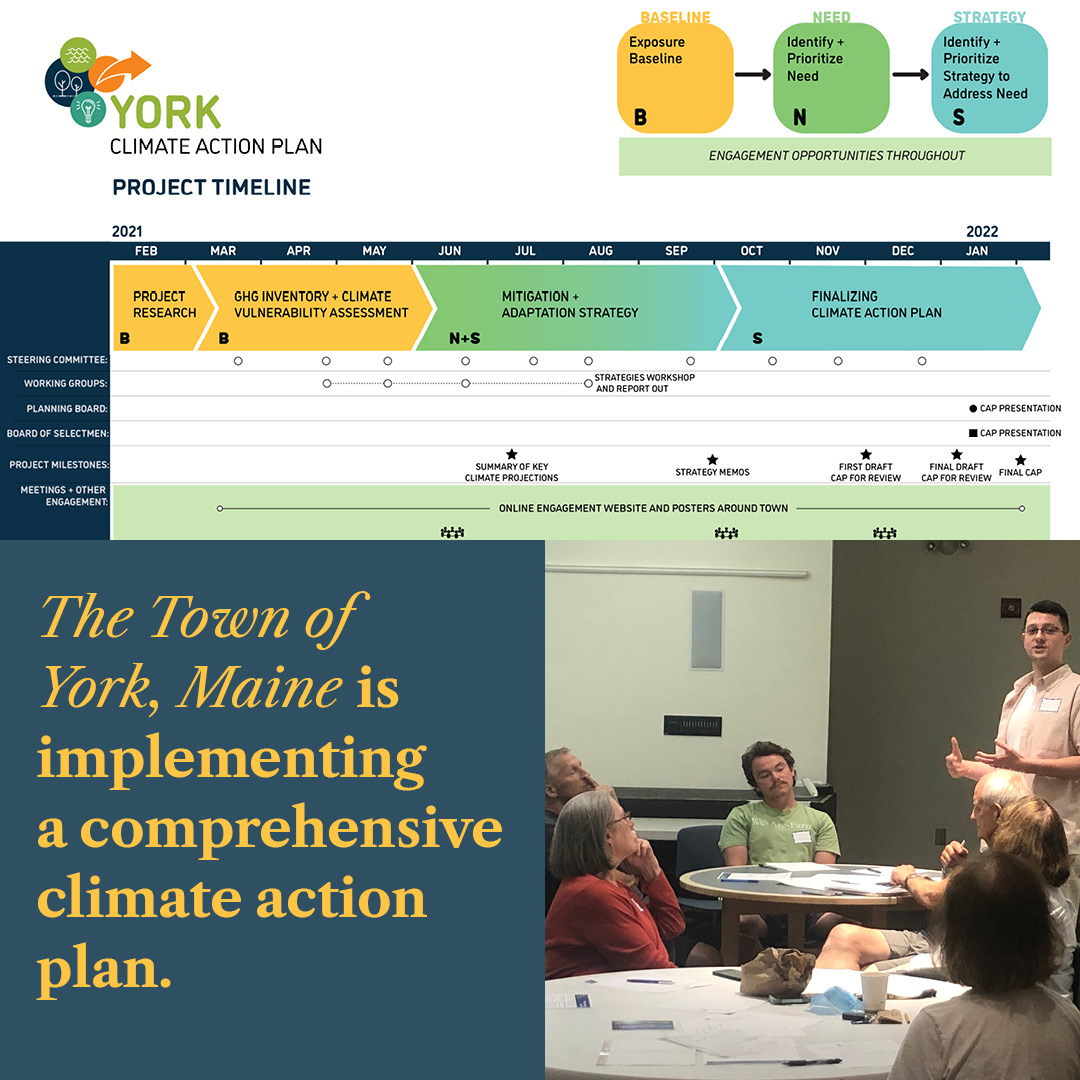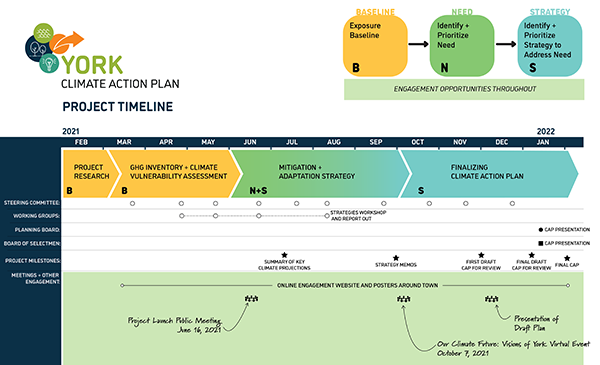
York Steps Up to Climate Risks with an Aggressive Action Plan
The town of York is stepping up to the significant risks posed by climate change to its miles of coastline, economy and abundant natural areas with an aggressive, comprehensive climate action plan.
Building from goals to cut greenhouse gas emissions by 50% by 2030 and achieve 100% carbon neutrality by 2050, the robust plan is the result of a collaboration of volunteers, consultant groups, civic organizations, Town staff and public feedback. York’s climate action roadmap directly supports many Maine Won’t Wait plan strategies.
We asked Gerry Runte, chair of the York Climate Action Plan Steering Committee to explain how the CAP came together - and for tips for other towns creating climate action plans.
- Why was it important for York to create a climate action plan?
With its miles of coastline, tourism and abundant natural areas, York is at significant risk from climate change. York has a long history of undertaking energy consumption and emission reduction initiatives, but it needed to expand its actions to adapt to climate change.
- What were the steps to forming York’s CAP?
In 2019 at the recommendation of York’s Energy Steering Committee, the Selectboard joined the Global Covenant of Mayors (GCoM) initiative and committed to reduce greenhouse gas emissions. Developing a climate action plan was one of the commitments required to become a member. Later in 2019, York voters approved hiring a consultant to prepare the York Climate Action Plan (CAP) and funded it with $150,000.
In April of 2020, the Steering Committee and Working Groups were established. The CAP Working Groups were charged with exploring potential strategies to reduce GHG emissions in York and to assist the Town in adapting to climate change.
Each Working Group was provided with an individual Handbook for its topic area with their overall charge, background information, references, and information to help guide meetings. The Handbook included considerations of recently added chapters to York’s current Comprehensive Plan, references to Maine’s State Climate Action Plan, and the expertise of the consultant. The consultant also provided the Working Groups with preliminary results from York’s GHG emissions inventory and an assessment of the town’s vulnerability to climate change.
In August 2021, each Working Group presented their top five strategies with background information on their choices. This was followed by a public joint meeting of all Working Groups and the Steering Committee to summarize and analyze the top strategies presented.
The Steering Committee and consultant team merged the recommended strategies into goals and actions to meet desired outcomes. These goals and actions were reviewed and revised by Steering Committee and Working Group members throughout the fall of 2021.
Check out a project timeline visual here or below.

- What are the focus areas that came out of this significant work?
Eight focus areas emerged:- Buildings
- Infrastructure
- Mobility
- Access to Renewable Energy
- Natural Resources
- Waste and Recycling
- Community Resiliency and Equity
- Leadership and Capacity
- What role did the Maine Won’t Wait plan play in York’s climate plan formation?
We modeled Maine Won’t Wait’s organization to form the various committees and working groups, although their charter was somewhat different from the State version. Unlike the State’s working groups, which were populated by experts in the topical areas, our working groups were made up of volunteers whose primary purpose was to “Yorkify” the consultant’s recommendations. In several circumstances, such as sea level rise, we adopted MWW’s projections and recommendations for preparatory design.
- What are the main goals of the York Climate Action Plan?
The main goals are summarized below. Find the complete goals, plan materials and recommendations to achieve the goals here.- Reduce GHG emissions generated by existing residential and commercial buildings
- Take steps to protect critical assets (water, sewer, public safety, access/evacuation roads, healthcare, Town services, dams, etc.) and other structures that will be impacted by sea level rise, storm surge, flooding and extreme weather events.
- Support the overall increase in the supply of renewable energy for all York citizens.
- Permanently conserve land, including wetlands and estuarine systems, and protect resources that provide carbon storage.
- Expand Electric Vehicle (EV) ownership and use.
- Reduce municipal solid waste (MSW).
- Create a Coordinated Climate and Health Response Team to address climate health and disaster risks in the community
- Ensure sufficient Town capacity to take action.
- Did you have any learnings to share with other towns creating climate plans?
The primary considerations we learned were:- Don’t try and do it alone. Hire a competent consulting firm with both sufficient technical depth and an awareness of what else is happening regionally and nationally, and follow their direction.
- Look for best practices elsewhere to avoid reinventing the wheel. There is only so much a small town can actually accomplish in the way of greenhouse gas reductions and there are not likely to be huge differences between goals and action items from one town’s climate plan to the next. Take a good look at what others have done with similar geography and population size.
- A solid greenhouse gas inventory and vulnerability assessment is an essential starting point and requires specific expertise to conduct. These assessments quickly allow identification of where efforts should be placed and how they should be prioritized.
- Wait until the GHG inventory is complete and a realistic assessment made of what can realistically be accomplished before setting reduction goals.
For more information about resources for towns and tribes to take climate action, visit our post about Community Action Grants.